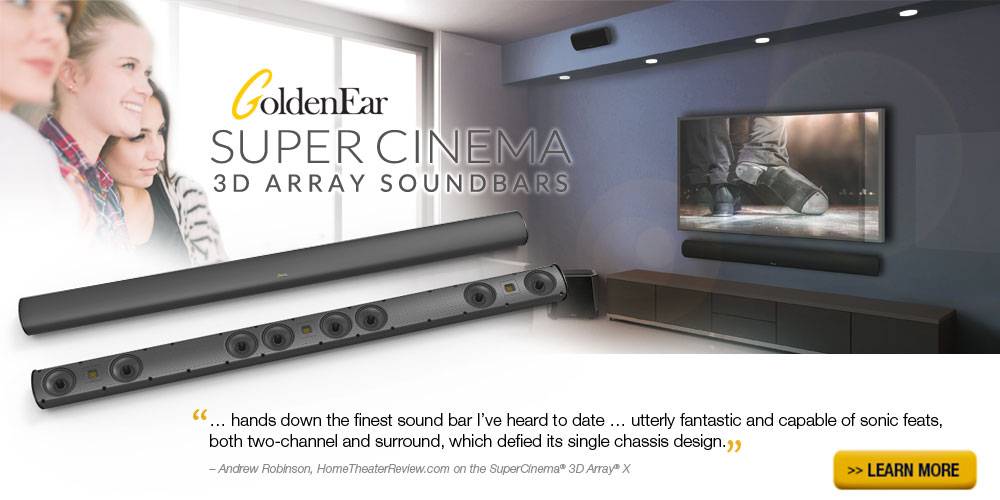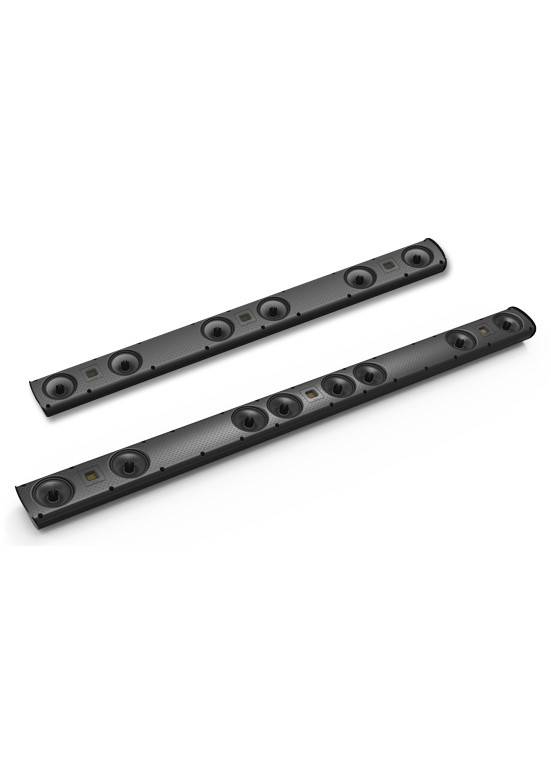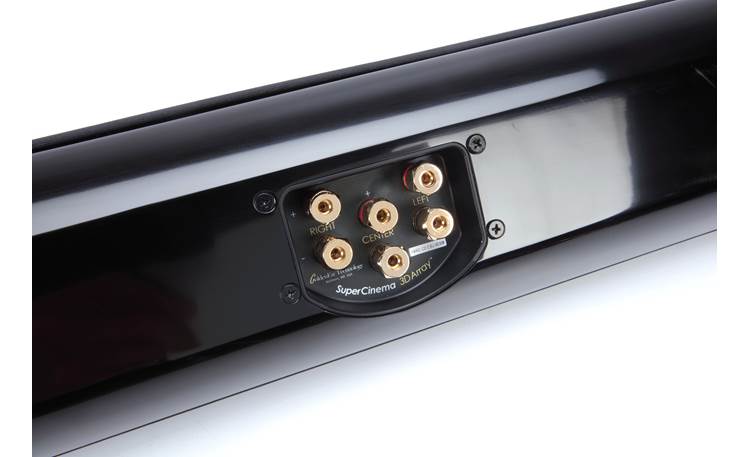GoldenEar SuperCinema® 3D Array®
Original price was: R24,000.00.R14,000.00Current price is: R14,000.00.
TRADITIONALLY, SOUNDBARS HAVE been ruled by tradeoffs. The deal goes like this: You relinquish a few expectations – namely, that you’ll get anywhere close to decent stereo imaging for music playback or true surround sound for movies – and in return you gain things like a simple, straightforward setup and a design that nicely complements your flatscreen. Everyone’s happy … kind of.
Indeed, for those with smaller home theater spaces and severe allergies to wires and cables, soundbar systems have been a nice shot of cortisone and a solid “good enough” option for years now. Add to that the fact that, regardless of price, they’re almost always far more capable than the sad little sound holes carved into the bottom of your HDTV and you can see why they’ve continued to thrive.
While it may look like other options out there, GoldenEar’s new SuperCinema 3D Array charts a slightly different course than its rectangular relatives. First, it doesn’t come packaged with its own wireless sub. You’ll have to pony up an extra $500 for the company’s ultra-compact, 1,000-watt ForceField 3 sub (more on this below). Or, if you’re feeling flush with cash, the $700 ForceField 4. Unlike our recent roundup of soundbar systems, this one’s also passive, meaning you’ll need an A/V receiver to power everything if you don’t own one already.
If those two requirements aren’t immediate deal-breakers – and they shouldn’t be – let me assure you the payoff is immense.
It’s both an engineering triumph and, even more importantly, one of those rare products that turns an entire category on its head.The SuperCinema array system doesn’t just eradicate nearly every sonic concession the category has thrust upon its owners; it proves once and for all that, yes, a 2.7-inch thin, 49-inch wide array of speakers can sound as good as (if not better than) a pair of great stereo speakers. In short, it’s both an engineering triumph and, even more importantly, one of those rare products that turns an entire category on its head.
Again, none of this is obvious just by looking at the SC3DA. As far as its design goes, this soundbar resembles a lot of other slimline systems currently on the market. It has the now-standard glossy piano-black finish, and at 4.75 inches tall, it’ll fit nicely in front of most HDTVs without obstructing the picture. Closer examination reveals just how much effort was put into this soundbar, though. Whether it’s the beautifully finished aerospace-grade extruded-aluminum cabinet or the marble-powder-infused baffle and end-caps, everything fits together perfectly and feels solid as a rock.
Pop off the tightly woven, magnetic grill and you’ll discover other high-end accouterments, like the six 4.5-inch bass-midrange drivers along with three of GoldenEar’s high-velocity folded ribbon tweeters. The latter use folded (or pleated) planar magnetic diaphragms instead of the more traditional domes. These expand and contract like an accordion to produce sound. The benefit here is that because these types of tweeters have a larger surface area, they can also produce more sound with less motion. That, in turn, increases driver efficiency and minimizes distortion.
For the purposes of this review, GoldenEar also sent me two of its SuperSat 3s for surrounds, as well as a ForceField 3 sub, a tiny trapezoidal woofer which, it turns out, has massive amounts of low-end prowess itself. All told, the entire system runs just a hair under $2,000. It also bears mentioning that you really will need that low end, as both the 3-D array and the SuperSats are virtually devoid of bass. At $1,500 for the soundbar and sub, this could still be categorized as an unconditional steal when compared to high-end soundbar systems.
I decided to start things off with a bang. Well lots of bangs, really – and thuds and screaming and groaning and then some more bangs. Queuing up one of the most complex and punishing albums I could think of – the Swans’ The Seer – I figured it would be a worthy initial test to see just how musically proficient this 3-D array really was.
The album is a sort endurance test for both the listener and the speakers playing it, offering a huge range of instrumentation and styles – from electronic soundscapes to random field recordings to tribal drumming to choral chanting to delicate acoustic folk strumming. Oh, and there’s a jet engine too. In my experience, there are few albums better at exposing a speaker’s weaknesses.
After listening to the album twice (phew), I was hard pressed to find a single fault with the SuperCinema array. Jarboe’s bloodcurdling drones in “Piece of the Sky” and “The Seer Returns” rang out crystal clear, and contrasted nicely with guest vocalist Karen O’s vulnerable purr in the country-infused “Song for a Warrior.”
And then there’s the soundstage. We’re talking chasm-wide, encompassing every part of my medium-sized room. The Class-D ForceField 3 sub pulled more than its own weight, offering up incredible amounts of low-end impact while also blending in seamlessly with the soundbar.
Finishing things off with the “The Apostate,” a 23-minute rock opus filled with screeching, howling, flittering horns, relentless drumming, and ringing bells, it sounded as if the apocalypse was pouring out the SC3DA – no doubt just the way Swans frontman Michael Gira intended.
Moving onto more straightforward rock fare, like Tomahawk’s new single “Stone Letter,” the speakers proved equally immersive. Mike Patton’s menacing low-end whisper/growl sounded better than ever as it reverberated across the room before segueing into the song’s screeching chorus.
Even more electronic-tilted albums, like Kid606’s melodic (for him) Lost in the Game, sounded nothing short of amazing, with its cinematic blend of melancholic synths and buzzing organ tones enveloping everything in a moody sonic haze.

A key part to all this musical brilliance is an engineering sleight of hand GoldenEar employs to eliminate a nasty thing called inter-aural crosstalk, a disease endemic to many soundbars. Essentially, this is what happens when sound from the right speaker crosses over and finds it way to the wrong ear (your left) and vice versa. As you might gather, it’s a problem that occurs when there’s insufficient separation between left and right channels.
For all its musical acumen, the SuperCinema 3D Array also did amazing things for movies.GoldenEar solves this problem by placing the outermost woofers slightly closer to their respective tweeter channel and then using them not as bass drivers for the left and right channels but to spit out a crossed-over, out-of-phase signal that effectively cancels out sound from the opposite channels. It works like a charm.
For all its musical acumen, the SuperCinema 3D Array also did amazing things for movies. When watching the Criterion Blu-ray edition of Terry Gilliam’s dystopian materpiece Brazil, the DTS-HD Master Audio surround soundtrack, including Geoff Muldaur’s samba-like version of Ary Barroso’s 1939 song “Brazil,” sounded as dreamlike as ever. Even the deafening hum of paper-shuffling and typing in the bustling Ministry of Information, moved seamlessly from the front soundstage back to the rear SuperSats and conveyed an undeniable sense of being stuck in bureaucratic hell.
Likewise, the jaw-dropping cafe sequence in Inception, with all its multi-layered chaotic explosions combined with the added low-end pitched and manipulated moans and whale sounds, proved to be as terrifying as it was in the theater.
While the SuperCinema array was designed to be used with the SuperSats, even in their absence, the soundbar produced an amazingly rich and organic sound that reached to the extreme corners of the room (if not quite in back of me). Of course, it wasn’t quite true surround, but I much preferred it to any faux DSP implementations commonly used by other soundbars.
So often when reviewing pieces of A/V gear, a reviewer has to hedge or qualify a recommendation. You want to be realistic, acknowledging that what you might find utterly mind-blowing, might not even be shrug-worthy to the average buyer. Price is also hard to reconcile. What constitutes a good value? When do you push people toward a higher-priced item?

At the end of the day, I wasn’t able to come up with a completely hedge-free position, but the SuperCinema 3D array did make my job about as simple as it can get. If you’ve settled on purchasing a soundbar system: Buy the GoldenEar SuperCinema 3D Array. Period. I’m definitely going to.
WIRED Engineering perfection. A do-everything soundbar that rivals some of best discrete surround systems out there. The most musically inclined soundbar system I’ve heard. Amazing clarity and a super-sized soundstage. ForceField 3 offers massive output for both its size and price.
TIRED Unlike others soundbar systems, you’ll need an A/V receiver to power this one. Sub required. Bass response is virtually non-existent.
Description
Product highlights:
- passive sound bar with separate left, center, and right channels
- non-powered — connects to your home theater receiver’s front three channels
- optimized 3D Array delivers a deep, wide soundstage free of distortion
- six 4-1/2″ cast-basket midrange/bass drivers (two per channel)
- MVPP™ (Multi-Vaned Phase Plug) technology prevents crosstalk interference between left and right channels
- three HVFR™ (High Velocity Folded Ribbon) tweeters (one per channel)
- Mag-X Coupling™ Crossover Technology for detailed, smooth 3D imaging
- sleek, thin design
- designed to complement 48-60″ TVs
- aerospace-grade extruded aluminum cabinet with marble-powder infused baffles and end-caps
- power handling: 20-200 watts (per channel)
- frequency response: 80-35,000 Hz
- sensitivity: 91 dB
- impedance: 8 ohms
- wall-mountable with keyhole mounts or threaded brass inserts
- shelf-mountable with adjustable rear supports
- 49″W x 4-13/16″H x 2-7/8″D
- weight: 17 lbs.
- warranty: 5 years






